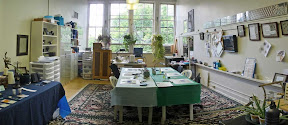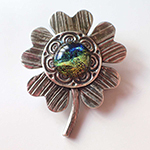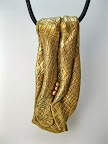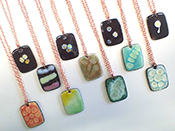I love rings. Have done so for years. I’ve bought some lovely ones, have received others as gifts: for years I’ve rarely left the house without wearing at least a couple rings.
Now, while I love metal clay too, I’m still trying to work up a passion for metal clay rings. In several of my earliest classes, we made rings. It’s a big deal, because you have to factor in the shrinkage as the metal clay fires.
I got a great feeling of _accomplishment_ from the first ring I made even though, from the design angle, the ring itself was not one of my all-time favorites. Here it is, in one of my early attempts at photographing jewelry (thus, the gray line down the inside is some quirk of the lighting; it’s not actually there on the ring):

Now, one way around some of the shrinkage concerns with rings is to make a flat strip that’s approximately the right size, fire it while still flat, and then bend it into the ring-shape. At that point, you can adjust its size and shape. Then you can add some other decorative piece, with various ways to connect that to the ends of your already-fired shank. One “traditional” option is to solder the components so they all hold together. Another “metal clay” approach is to use some form of the clay as your connector and refire the whole thing so the sintering will cause it all to hold together.
So, when Tim was here, one of the class projects was yet another ring. We used that “double-fire” method to build the ring. I was having some problems with it. Now, part of the problem was just me: some blocked ducts in my eyelids (leftovers from a “poison ivy incident” last fall, sigh) were making it a challenge for me to see really fine detail. Another part of the problem was that I was not confident how _what I was visualizing in my head that Tim was telling us to do_ would provide enough contact area to ensure a secure connection. I kept adding more silver clay (in the form of a paste supplemented by lavender oil), not trusting I’d gotten it right, and showing it to Tim to ask when I needed some more. He’d point out some issue, I’d add a bt more, and we continued like this for several rounds until he said it looked fine to him.
Me, I could visualize different constructions that should hold better. And those would involve the use of clay (“grout”) rather than paste (“simple glue”) to make the connections. Did my hesitations jinx the project? I don’t know about that but (a) in the end it came out too small (first ring I’ve ever had that happen with) and (b) after several times of putting it on and off a smaller finger than the one where I’d thought I’d wear a ring of that design, it did still pull apart.
Silly me: in my disappointment, I didn’t think to take a photo of it before I started fiddling with the components. I just took the shank, and used it to try a different construction technique.

I’m much happier with that ring! Yes, there is a very slight crack–that happened during the second firing–and I see it’s already picked up a scratch in the couple of days I’ve been wearing it. I could fix all that, but I consider this a trial-ring, so I’m going to just continue to wear it as-is for a while and see how it holds up. The little almost-square piece with a cubic zirconia (CZ) set into it is what broke out of the ring as I’d originally made it in Tim’s class. I’ll put that aside, and find some other piece in which to use it.
And that is part of what I do enjoy about all of this: even a failure doesn’t end up as a total loss. I can reuse the components in different ways, and learn new things in the process.

 Artsmiths of Pittsburgh
Artsmiths of Pittsburgh Hoyt Center for the Arts, New Castle, PA
Hoyt Center for the Arts, New Castle, PA Portage Hill Gallery, Westfield, NY
Portage Hill Gallery, Westfield, NY _Open Houses in my Studio
_Open Houses in my Studio _Or…contact me about hosting a private party!
_Or…contact me about hosting a private party!














